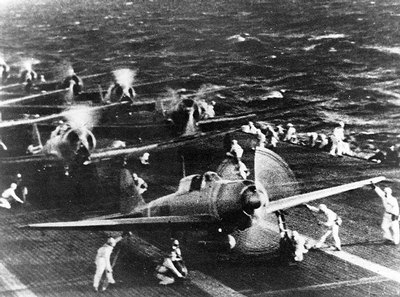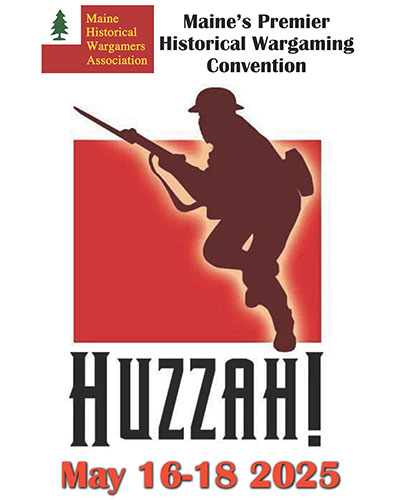
 All the games made by Avalon Hill try their best to be entertaining, fun, and historically accurate…to some degree. How does their newest collectible mini game, War @ Sea, as part of the Axis & Allies line (per Wizards of the Coast and thus Hasbro) hold up to historical accountability?
All the games made by Avalon Hill try their best to be entertaining, fun, and historically accurate…to some degree. How does their newest collectible mini game, War @ Sea, as part of the Axis & Allies line (per Wizards of the Coast and thus Hasbro) hold up to historical accountability?
The book states that, as most historians know, the Japanese fleet attacking Pearl Harbor had 6 carriers acting as mobile bases for the aircraft making the attack. The carriers: Akagi, Hiryu, Kaga, Shokaku, Soryu, and Zuikaku, launch a collective total of 183 aircraft for the first wave. The book clearly says that the 6 carriers brought 441 aircraft to the fight. 183 were launched in the first wave and 168 in the second.
The Akagi, the only carrier of its type, had a complement of 91 aircraft according to Wikipedia. We see on the card that the Akagi can carry 3 aircraft. This works out to each aircraft model in War @ Sea representing 33 1/3 actual aircraft for this vessel. Additionally, we can see that the Akagi carried almost 21% of the aircraft brought to attack Pearl Harbor. For those interested in the actual composition per wave Wikipedia tells us that 29 Kates and 9 Zeroes participated in the first wave. 18 Vals composed Akagi’s second wave of attack.
Next, we have the Hiryu, one of the Soryu class of carriers, who carried 73 planes. Unfortunately there is no model in War @ Sea to represent this class of carriers. It is a fleet carrier smaller than the Akagi and as far as War @ Sea is concerned we can liken it to the Shokaku class. The card for the Shokaku, like the Akagi, shows a capacity of 3 aircraft. If we hold this to be true for the War @ Sea version of the Soryu carriers, which do not exist in game, then each aircraft model in game represents 23 1/3 actual aircraft. We also can tell that the Hiryu carried almost 17% of the aircraft to Pearl. We know that the Hiryu launched a single wave of 18 Kates and 10 Zeroes on Pearl Harbor.
The Soryu, in all regards the same in makeup as the Hiryu, launched 2 waves at Pearl. We can therefore say that like the Hiryu, Soryu carried 17% of the aircraft to Pearl and probably launched similiar compositions of aircraft, in each wave, as Hiryu did in its one.
Moving on to the Kaga we encounter a vessel of a different class from any other ship in the Imperial Japanese Navy…much like the Akagi. In many respects, at least on the most basic level, both ships are alike. Therefore, we will reference the card for the Akagi to determine the Kaga’s impact in War @ Sea as no actual model of the Kaga exists for the game. The Kaga, like the Akagi, had a complement of 91 aircraft. We see on the Akagi’s card that the Akagi can carry 3 aircraft. This works out to each aircraft model in War @ Sea representing 33 1/3 actual aircraft for this vessel. Additionally, we can see that the Kaga carried almost 21% of the aircraft brought to attack Pearl Harbor. In the first wave it launchd 26 Kates and 9 Zeroes. Its second wave was composed of 26 Vals.
So far after examining 4 of the carriers we have covered 328 aircraft and 74% of the aerial complement. Let us therefore move on to the Shokaku class covering both the Shokaku and Zuikaku.
Both vessels carried 69 aircraft, each, to the attack on Pearl Harbor. Their complement was 15 Zeroes, 27 Kates, and 27 Vals each. This works out to nearly 17% of the total force per carrier. Once again looking at the card for the Shokaku we see it can carry 3 aircraft in game. It works out to each plane, in game, representing 23 actual aircraft. The Zuikaku launched 25 Vals and 5 Zeroes in the first wave. It then launched 27 Kates and 17 Vals in its second wave. If we hypothesize that the Shokaku did the same we can replicate those numbers.
Looking at the total of planes launched in the first wave we arrive at a sum of 217 aircraft. This is 34 more than the number given in White’s book. Doing the same for the second wave we arrive at the number 132. That’s a total of 36 less than the stastistic provided by White. Our grand total is 349 or 92 planes less than the number we’ve been given. We admit that some data is not available for each wave from certain ships. But, 92 planes is quite a lot to be missing and is far outside the realm of error.
What does this tell us about the historical accuracy of the game? The models for the Zero (or Zeke), Kate, and Val show 3 planes on the base. This could serve to represent an entire squadron of aircraft and although we know that entire squadrons did not launch, at times, in each of the waves it is still telling.
Overall it looks like the game designers did their best with what they have. The game is not completely historically accurate nor do we want it to be. It is not a simulation nor does it bill itself as one. I do not believe the basing capacity of the carriers in the game, in regards to Japan, are accurate when compared to the data we’ve shared here. But, and this is an important but, that doesn’t matter. The game gives up some accuracy for speed, efficiency, and fun. I’m glad it does and I’d make that trade any day.


